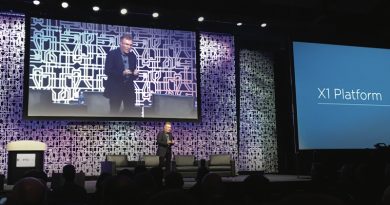Future-Proofing Cable Access Networks
By Marty Glapa
We are wirelessly connected nearly all the time via mobile phones, smart devices, PCs, or smart TVs, terminating on technology-specific wireless access nodes. We are also frequently hardwire connected via devices such as phones, TVs or PCs, through various copper, fiber, or coax technologies terminating on technology-specific wireline access network nodes. And, we are often simultaneously using wireless and wireline services.
Separate platforms and networks create challenges including limited ability to integrate wireless and wireline services, finding suitable real estate to locate multiple nodes, and spending CapEx and OpEx for multiple platforms. And, as technology changes, access platforms often need to be replaced because the hardware is not programmable.
As bandwidth demands increase from hundreds of megabits to tens of gigabits, and as service latency requirements decrease from tens or hundreds of milliseconds to one or two milliseconds, wireless (5G mmWave and cmWave, Wi-Fi) and wireline access nodes (cable and copper) will be pushed deeper into neighborhoods, to within 100 meters to 300 meters of customers. This enables an increase in spatial and spectral reuse — reducing the number of customers served to several dozen per serving node, and reducing round-trip control and data signaling delays. With both wireless and wireline access platforms located to within 100 meters or so of customers, this becomes an ideal location to converge these technologies onto a single access network platform.
Network function virtualization (NFV) and software defined networking (SDN) have given rise to disaggregation of functionality that typically resides in bespoke hardware and software platforms. This approach enables automation and makes the network programmable. The next step beyond NFV and SDN is to make the underlying hardware platform programmable so that it can be reconfigured and reused for multiple purposes. Bell Labs Research has prototyped such a “Future Remote” (FR) access network platform that is programmable not only to support a single access technology, but also both wireline and wireless access technologies simultaneously. On the subscriber facing side, a FR is equipped with various wireless or wireline (or both) technology analog front-end (AFE) pluggable modules. An AFE module implements a set of typical analog functions including power amplification, RF mixing and filtering for an application. Beside the AFE modules, the core of a FR is a universal PHY system-on-chip (uPHY-SoC) which is realized as a programmable and reconfigurable ASIC. A uPHY-SoC implements a variety of digital baseband physical layer signal processing functions and/or MAC protocols that are common to and shared by both wireless and wireline access technologies, and the network side interface, e.g., a passive optical network termination or an Ethernet interface. The operations, administration and management as well as control functions of a FR are performed over an open SDN control and management interface.
Bell Labs Consulting created a detailed total cost of ownership analysis comparing discrete wireline and wireless access platform deployment models against models using a converged FR platform containing both wireline and wireless hardware. Three different morphologies — urban, suburban and dense urban — were analyzed. The wireless system coverage was line-of-sight (LOS) with nomadic application, and the wireline access was DOCSIS®. Analysis results indicate that collocating wireless and wireline functions on the same converged FR access platform enables 38% to 40% total cost of ownership (TCO) savings, depending on morphology, over building discrete wireless and wireline access networks. Benefits are derived primarily from common hardware, shared site acquisition, common fiber backhaul, powering, real estate and maintenance.
The FR is an ideal platform for cable operators to build a future-proof converged wireless/wireline access network.


Marty Glapa
Partner and Bell Labs Fellow,
Bell Labs Consulting
Marty Glapa is responsible for intellectual property development, R&D, strategy, and forward-looking work. His experience includes consulting services development and delivery, network planning, network and business modeling, systems engineering, business development, and product development. Marty has four patents and a Master’s Degree in Computer Science from DePaul University.
The complete paper is available to SCTE•ISBE members at:




